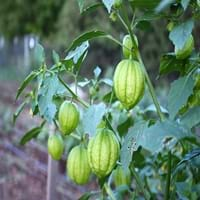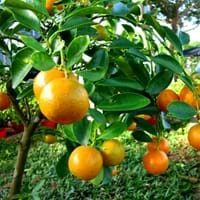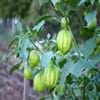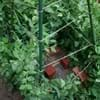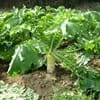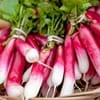Life Span
Annual
Perennial
Origin
Mexico, Caribbean, Central America
Southeastern Asia, Japan
Types
Green Tomatillo, Purple Tomatillo
Clementines, dancy, fallglo, lee
Habitat
Cultivated Beds
Subtropical climates, Tropical regions
USDA Hardiness Zone
6-9
8-11
Sunset Zone
A3, H1, H2, 1a, 1b, 2a, 2b, 3a, 3b, 4, 5, 6, 7, 8, 9, 10, 11, 12, 13, 14, 15, 16, 17, 18, 19, 20, 21, 22, 23, 24
H1, H2, 8, 9, 12, 13, 14, 15, 16, 17, 18, 19, 20, 21, 22, 23, 24
Habit
Oval/Rounded
Oval or Rounded
Flower Color
Yellow, Sandy Brown
White, Red, Purple
Flower Color Modifier
Bicolor
Bicolor
Fruit Color
Green, Purple, Yellow green
Green, Orange
Leaf Color in Spring
Green
Green, Dark Green
Leaf Color in Summer
Green
Green, Dark Green
Leaf Color in Fall
Green
Green, Dark Green
Leaf Color in Winter
Not Available
Light Green
Leaf Shape
Lance shaped
Lance shaped
Plant Season
Spring, Summer, Fall, Winter
Spring, Summer, Fall, Winter
Sunlight
Full Sun
Full Sun, Partial Sun
Growth Rate
Very Fast
Medium
Type of Soil
Clay, Loam, Sand
Loam, Sand
The pH of Soil
Neutral
Acidic, Neutral
Soil Drainage
Well drained
Well drained
Bloom Time
Indeterminate
Spring, Late Spring, Early Summer
Tolerances
Drought
Drought
Where to Plant?
Container, Ground
Ground
How to Plant?
Seedlings
Grafting, Seedlings
Plant Maintenance
Medium
Medium
Watering Requirements
Average Water Needs
Average Water Needs, occasional watering once established, Water more in summer
In Summer
Drought Tolerant, Average Water
Lots of watering
In Spring
Moderate
Moderate
In Winter
Average Water
Average Water
Soil pH
Neutral
Acidic, Neutral
Soil Type
Clay, Loam, Sand
Loam, Sand
Soil Drainage Capacity
Well drained
Well drained
Sun Exposure
Full Sun
Full Sun, Partial Sun
Pruning
Remove all suckers, Remove wet foliage
Remove damaged leaves, Remove dead branches, Remove dead leaves, Requires little pruning
Fertilizers
All-Purpose Liquid Fertilizer
20-10-10, All-Purpose Liquid Fertilizer
Pests and Diseases
Fungal Diseases
Aphids, Beetles, Earwigs, Leafminers, Red blotch
Plant Tolerance
Drought
Cold climate, Drought
Flowers
Insignificant
Showy
Flower Petal Number
Single
Single
Fragrant Bark/Stem
No
Yes
Foliage Texture
Medium
Medium
Foliage Sheen
Matte
Glossy
Attracts
Birds, Flea beetles
Beetles, Birds, Butterflies, Insects, Leaf Hoppers, Rabbits
Allergy
Arthritis, Inflammation
no allergic reactions
Aesthetic Uses
Not Used For Aesthetic Purpose
Not Used For Aesthetic Purpose
Beauty Benefits
Good for skin
Glowing Skin, Skin Problems
Environmental Uses
Air purification
Air purification
Medicinal Uses
Cancer, Diabetes, Energy, Opthalmic
Aging, Antioxidants, High blood pressure, High cholestrol, Skin Disorders
Part of Plant Used
Fruits
Fruits
Other Uses
Used for making green salsas and chilli sauce, Used in salads
Used for its medicinal properties
Used As Indoor Plant
No
Yes
Used As Outdoor Plant
Yes
Yes
Garden Design
Edible, Herb / Vegetable
Container, Edible, Feature Plant, Fruit / Fruit Tree, Hedges, Houseplant, Mixed Border, Topiary / Bonsai / Espalier
Botanical Name
PHYSALIS philadelphica
CITRUS reticulata 'Armstrong'
Common Name
Green Tomato, Mexican Groundcherry, Tomatillo
Armstrong Tangerine, Tangerine
In Hindi
Tomatillos
संतरा
In German
Tomatillos
Mandarine
In French
Tomatilles
mandarine
In Spanish
Tomatillos
mandarina
In Greek
Tomatillos
μανταρίνι
In Portuguese
Tomatillos
tangerina
In Polish
Tomatillos
mandarynka
In Latin
Tomatillos
Tangerine
Phylum
Magnoliophyta
Magnoliophyta
Class
Magnoliopsida
Magnoliopsida
Order
Solanales
Sapindales
Family
Solanaceae
Rutaceae
Clade
Angiosperms, Asterids, Eudicots
Angiosperms, Eudicots, Rosids
Tribe
Physaleae
Not Available
Subfamily
Solanoideae
Not Available
Number of Species
Not Available
Not Available
Importance of Tomatillo and Tangerine
Want to have the most appropriate plant for your garden? You might want to know the importance of Tomatillo and Tangerine. Basically, these two plants vary in many aspects. Compare Tomatillo and Tangerine as they differ in many characteristics such as their life, care, benefits, facts, etc. Every gardener must at least have the slightest clue about the plants he wants to plant in his garden. Compare their benefits, which differ in many ways like facts and uses. The medicinal use of Tomatillo is Cancer, Diabetes, Energy and Opthalmic whereas of Tangerine is Aging, Antioxidants, High blood pressure, High cholestrol and Skin Disorders. Tomatillo has beauty benefits as follows: Good for skin while Tangerine has beauty benefits as follows: Good for skin.
Compare Facts of Tomatillo vs Tangerine
How to choose the best garden plant for your garden depending upon its facts? Here garden plant comparison will help you to solve this query. Compare the facts of Tomatillo vs Tangerine and know which one to choose. As garden plants have benefits and other uses, allergy is also a major drawback of plants for some people. Allergic reactions of Tomatillo are Arthritis and Inflammation whereas of Tangerine have no allergic reactions respectively. Having a fruit bearing plant in your garden can be a plus point of your garden. Tomatillo has showy fruits and Tangerine has showy fruits. Also Tomatillo is not flowering and Tangerine is not flowering . You can compare Tomatillo and Tangerine facts and facts of other plants too.
